Lifejackets in the test: How good are 15 models with 150 newtons of buoyancy?
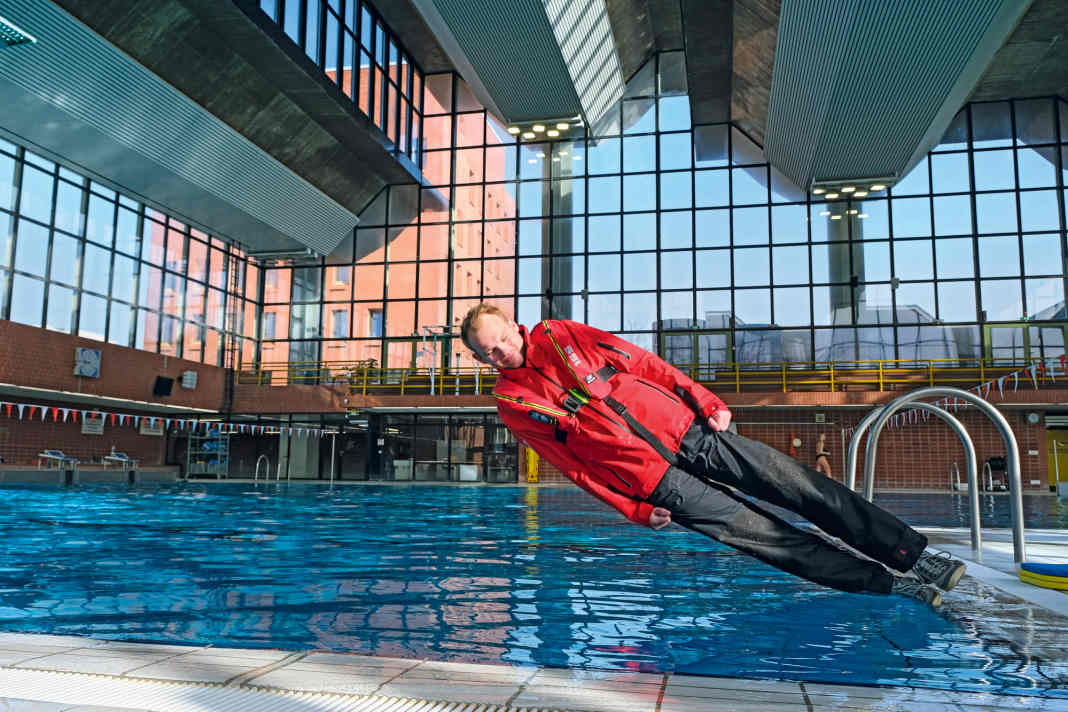





All content in this security special:
- Sea survival training for emergencies
- Stretch ropes: The correct handling of lifelines
- Lifejackets: 24 automatic lifejackets in a large comparison test (150N & 275N)
- Emergency transmitters - alerting, searching and finding, a system overview
- You should master these MOB manoeuvres!
- Back on board with tricks and professional recovery aids
- Safety check: Inspection saves lives
- Prepared for an emergency: 6 checklists for 6 scenarios
A lifejacket must work in an emergency, inflate automatically and then keep the head of the person who has fallen overboard above water. For the test, our tester always dropped into the water in the swimming pool in the same way. This ensured a repeatable test set-up. With the 150 models, we went into the water from the side with light oilskins. However: Standard EN Iso 12402, which determines the minimum buoyancy of a lifejacket in sea areas, does not stipulate that lifejackets with a buoyancy of 150 newtons should be worn with oilskins. Although oilskins are supposed to be impermeable, this property is a hindrance in MOB situations, as trapped air cannot escape quickly from the garments. However, these air pockets in the jacket and trousers change a person's buoyancy considerably and may therefore counteract the buoyancy of the lifejacket.
In concrete terms, this means that if you lie on your stomach in the water, you will not be turned reliably. You can only breathe freely when lying on your back. According to the standard, waistcoats in the 150 Newton class cannot turn anyone wearing oilskins into a supine position where they cannot pass out. This has also been confirmed by our practical tests. This is why the distinction between these buoyancy classes in the test is crucial. Contrary to the swimwear specified in the ISO standard for testing the 150 Newton waistcoats, we tested with oilskins and sailing shoes, as this mostly reflects reality.
15 lifejackets with at least 150 newtons of buoyancy tested:
Values in brackets: maximum number of points achievable in the legend, actual number of points achieved in the table
170N Offshore Lifejacket Pro



- Provider: teamomarine.com
- Manufacturer: TeamO
- Price (15): 264 € (3)
- Buoyancy: 170 N
- Propellant cylinder/triggering: 38 g/water contact
- Automatic machine: UML Pro Sensor Elite
- Viewing window/control: Yes/tablet/cartridge
- Lifebelt: Belt loop, soft, backtow
- Belt concept adjustment: Chest strap adjustable with two metal buckles on the back
- Belt fastener: Buckle, stainless steel
- Crotch strap (4): Double (4)
- Spraycap (4): Yes (4)
- Signal light (4): Yes (4)
- Closure cover: Zip fastener
- Weight (10): 1.445 g (2)
- Funct. & swimming position (20): 5
- Freeboard (20): 11.4 cm (6)
- Additional equipment (3): Backtow Harness (3)
- Wearing comfort, belt adjustment (20): Good, easily self-adjustable and comfortable harness. Space in the neck (16)
- Remark: Twisted buoyancy when opened, slides up to the forehead and has a large wave channel
- YACHT rating: Satisfactory (47)
180N Racer ISO Lifejacket (YACHT price-performance tip)



- Provider: marinepool.com
- Manufacturer: Loading OÜ
- Price (15): 110 € (12)
- Buoyancy: 180 N3
- Propellant cylinder/triggering: 8 g/water contact
- Automatic machine: UML-5
- Viewing window/control: No/tablet/cartridge
- Lifebelt: D-ring, metal
- Belt concept adjustment: Chest strap with plastic buckle
- Belt fastener: Buckle, stainless steel
- Crotch strap (4): Simple (4)
- Spraycap (4): No (0)
- Signal light (4): No (0)
- Closure cover: Velcro
- Weight (10): 1.037 g (7)
- Funct. & swimming position (20): 16
- Freeboard (20): 14.4 cm (20)
- Additional equipment (3): Envelope is part of the buoyancy (2)
- Wearing comfort, belt adjustment (20): Very simple harness, awkward. Somewhat cramped in the neck (11)
- Remark: No wave channel, high freeboard, very easy to pack after release
- YACHT rating: Good (72)
3D Ergo-Fit Pro 150N
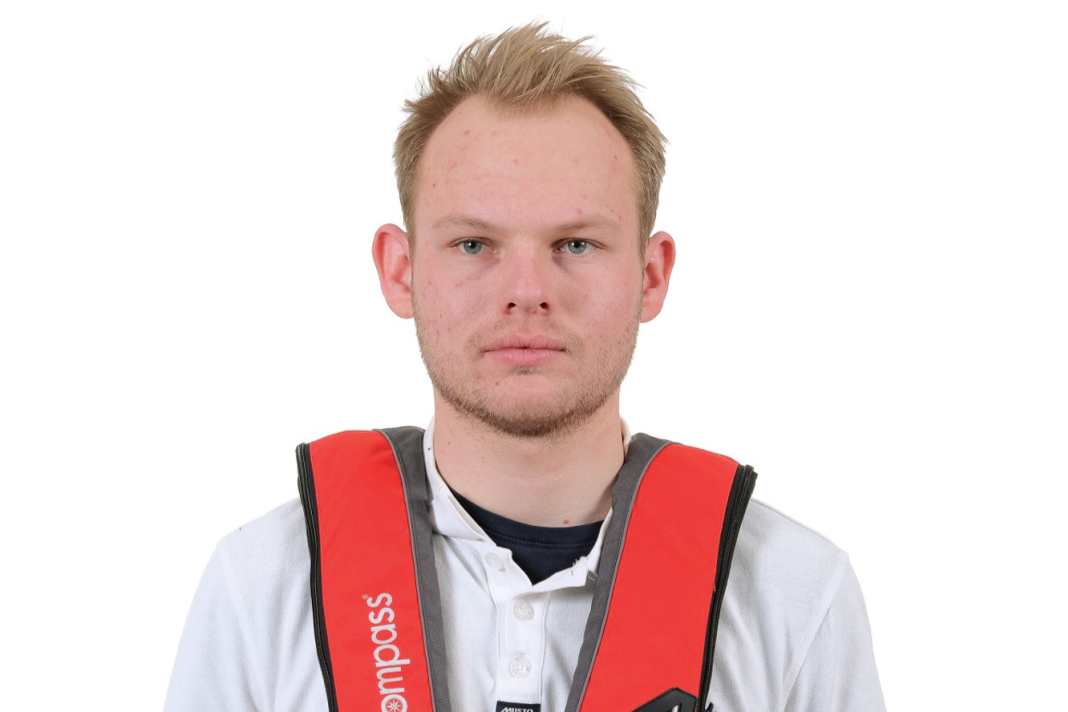


- Provider: Compass24.de
- Manufacturer: Loading OÜ
- Price (15): 130 € (11)
- Buoyancy: 150 N
- Propellant cylinder/triggering: 33 g/water contact
- Automatic machine: UML Pro Sensor Elite
- Viewing window/control: Yes/tablet/cartridge
- Lifebelt: Belt loop, soft
- Belt concept adjustment: Adjustable chest strap with plastic buckle on the back
- Belt fastener: Buckle, stainless steel
- Crotch strap (4): Simple (4)
- Spraycap (4): No (0)
- Signal light (4): No (0)
- Closure cover: Zip fastener
- Weight (10): 910 g (9)
- Funct. & swimming position (20): 10
- Freeboard (20): 9.6 cm (0)
- Additional equipment (3):Fleece collar (2)
- Wearing comfort, belt adjustment (20): Very simple and not very intuitive harness. Freedom of movement o. k. (13)
- Remark: Asymmetrical buoyancy chamber, light wave channel
- YACHT rating: Satisfactory (49)
Athena 165
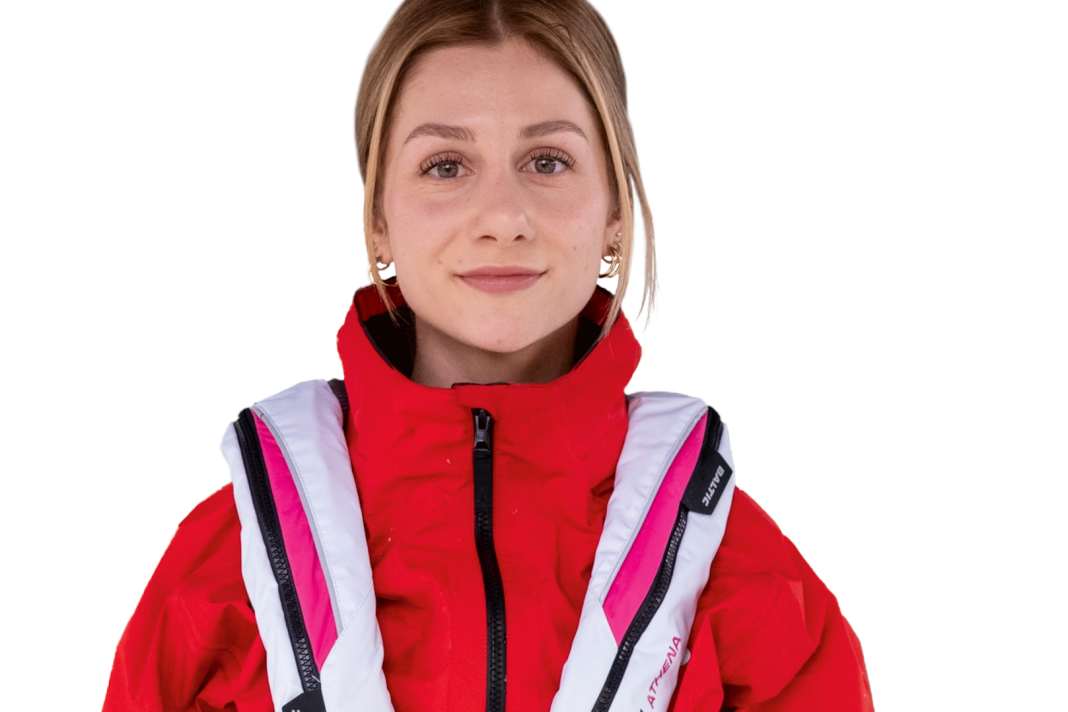


- Provider: Element-2.de
- Manufacturer: Baltic
- Price (15): 230 € (5)
- Buoyancy: 165 N
- Propellant cylinder/triggering: 33 g/water contact
- Automatic machine: UML Pro Sensor Elite
- Viewing window/control: Yes/tablet/cartridge
- Lifebelt: Belt loop, soft
- Belt concept adjustment: Chest strap adjustable at the front left, self-stowing strap. Optimised for women
- Belt fastener: Buckle, stainless steel
- Crotch strap (4): Simple (4)
- Spraycap (4): No (0)
- Signal light (4): No (0)
- Closure cover: Zip fastener
- Weight (10): 1.090 g (7)
- Funct. & swimming position (20): 18
- Freeboard (20): 13.5 cm (16)
- Additional equipment (3): Padded back and neck (3)
- Wearing comfort, belt adjustment (20): Harness is simple but good. Very nicely shaped back section. Plenty of room in the neck (18)
- Remark: Waistcoat specially optimised for the female anatomy. Fits very well even when inflated
- YACHT rating: Good (71)
Crewfit+ 180N Pro (YACHT test winner)
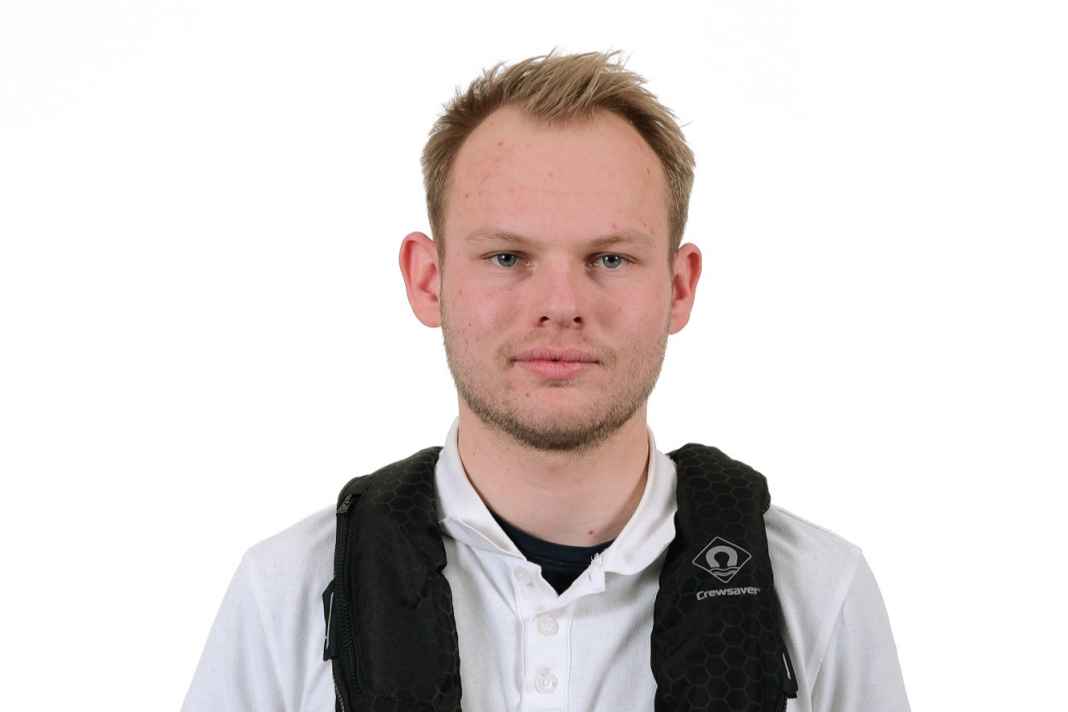


- Provider: nordwest-funk.eu
- Manufacturer: Crewsaver
- Price (15): 209 € (6)
- Buoyancy: 180 N
- Propellant cylinder/triggering: 38 g/water contact
- Automatic machine: UML Pro Sensor Elite
- Viewing window/control: No/tablet/cartridge
- Lifebelt: Belt loop, hard
- Belt concept adjustment: Chest strap adjustable on both sides using metal buckles with opening aid
- Belt fastener: Buckle, stainless steel
- Crotch strap (4): Simple (4)
- Spraycap (4): Yes (4)
- Signal light (4): Yes (4)
- Closure cover: Zip fastener
- Weight (10): 1.215 g (5)
- Funct. & swimming position (20): 17
- Freeboard (20): 13.2 cm (15)
- Additional equipment (3): Separate zip for cartridge (2)
- Wearing comfort, belt adjustment (20): Comfortable fit, plenty of room, especially in the neck. Well adjustable harness (17)
- Remark: Buoyancy chamber does not allow water to reach the mouth, spray cap fits well, good visibility
- YACHT rating: Good (74)
Deckvest 6D 170N Elite



- Provider: frisch.de
- Manufacturer: Spinlock
- Price (15): 359 € (0)
- Buoyancy: 170 N
- Propellant cylinder/triggering: 33 g/water contact
- Automatic machine: UML Pro Sensor Elite
- Viewing window/control: Yes/tablet/cartridge
- Lifebelt: Belt loop, hard
- Belt concept adjustment: Chest strap with two metal buckles on the side at the front, self-stowing strap
- Belt fastener: Plastic gag
- Crotch strap (4): Simple, wide (4)
- Spraycap (4): Yes (4)
- Signal light (4): Yes (4)
- Closure cover: Zip fastener
- Weight (10): 1.257 g (5)
- Funct. & swimming position (20): 7
- Freeboard (20): 12.6 cm (12)
- Additional equipment (3): Mesh bag for storage (2)
- Wearing comfort, belt adjustment (20): Comfortable at the neck and shoulders, very easy to adjust. Intuitive fastening (18)
- Remark: Large wave channel, sealed by spraycap, but not powerless. Sits very high up
- YACHT rating: Satisfactory (56)
Deckvest LITE+ 170N
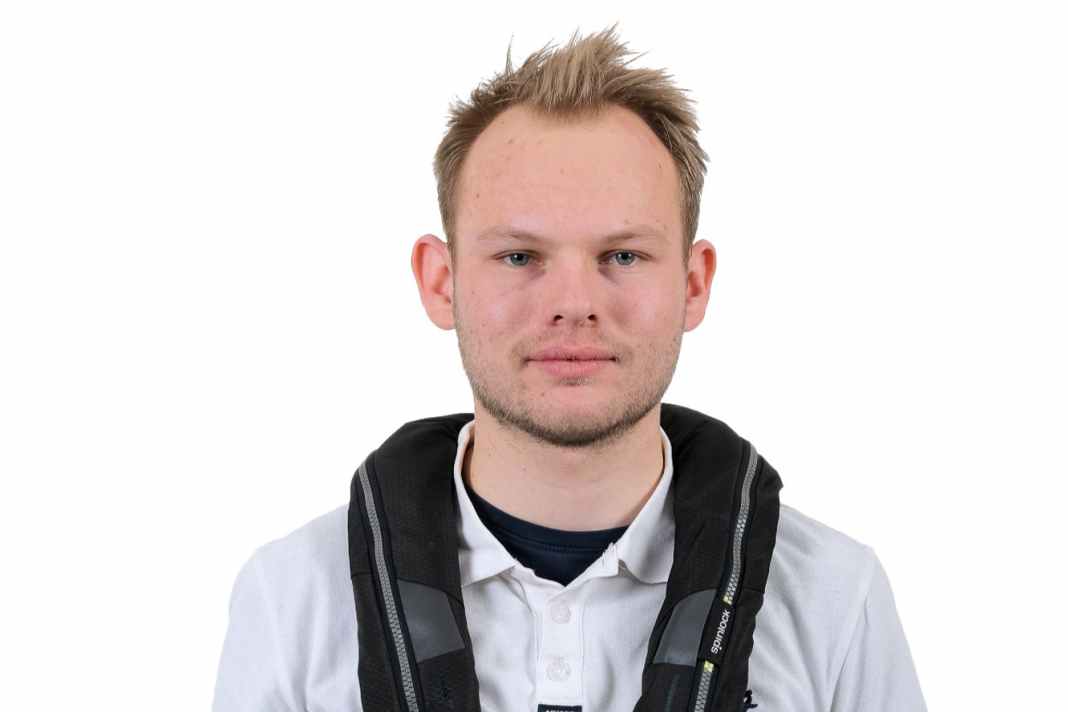


- Provider: frisch.de
- Manufacturer: Spinlock
- Price (15): 229 € (5)
- Buoyancy: 170 N 33 g/water contact
- Propellant cylinder/triggering:
- Automatic machine: UML-5
- Viewing window/control: No/tablet/trigger
- Lifebelt: Belt loop, hard
- Belt concept adjustment: Chest strap adjustable at the front right with buckle, self-stowing strap
- Belt fastener: Buckle, anodised aluminium
- Crotch strap (4): Simple (4)
- Spraycap (4): No (0)
- Signal light (4): No (0)
- Closure cover: Zip fastener
- Weight (10): 890 g (10)
- Funct. & swimming position (20): 9
- Freeboard (20): 12.0 cm (9)
- Additional equipment (3): Mesh bag for storage (2)
- Wearing comfort, belt adjustment (20): Adjustment a little awkward. Very light waistcoat, but a little tight around the neck (14)
- Remark: Buoyancy leaves a large wave channel, but sits comfortably. Rather simple (inshore)
- YACHT rating: Satisfactory (53)
Deckvest LITE+ 170N Sail
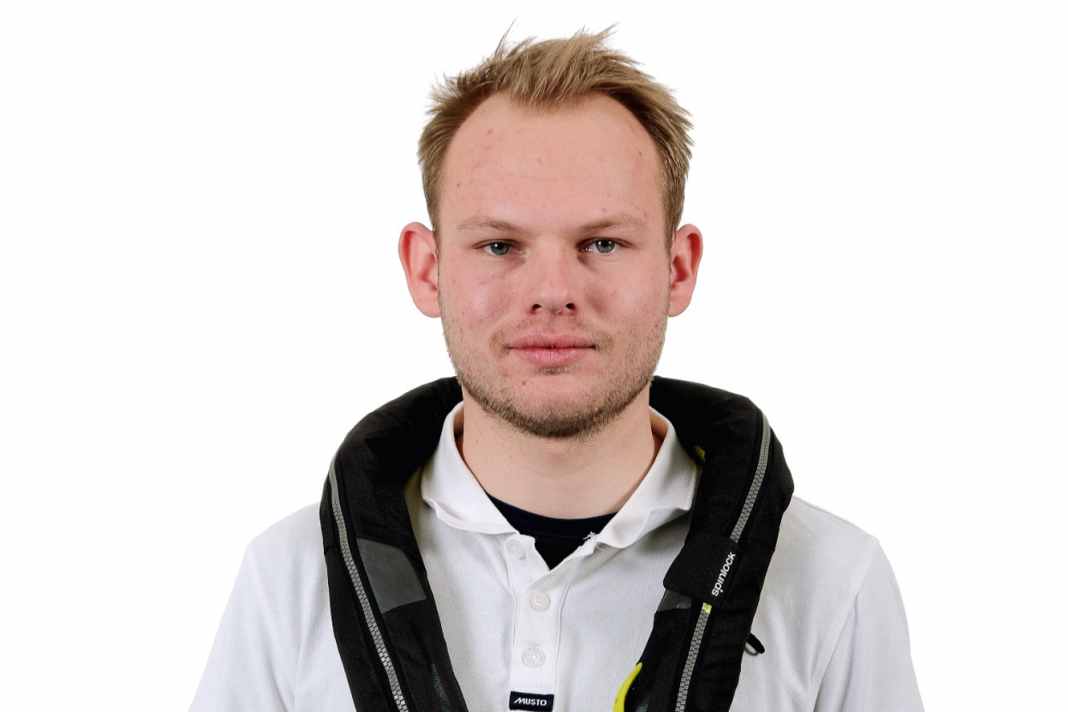


- Provider: fresh.com
- Manufacturer: Spinlock
- Price (15): 259 € (3)
- Buoyancy: 170 N
- Propellant cylinder/triggering: 33 g/water contact
- Automatic machine: UML-5
- Viewing window/control: No/tablet/trigger
- Lifebelt: Belt loop, hard
- Belt concept adjustment: Chest strap adjustable at the front right with buckle, self-stowing strap
- Belt fastener: Buckle, anodised aluminium
- Crotch strap (4): Simple (4)
- Spraycap (4): Yes (4)
- Signal light (4): Yes, LumeOn (4)
- Closure cover: Zip fastener
- Weight (10): 1.032 g (8)
- Funct. & swimming position (20): 9
- Freeboard (20): 12.0 cm (9)
- Additional equipment (3): Mesh bag for storage (2)
- Wearing comfort, belt adjustment (20): Adjustment a little awkward. Very light waistcoat, but a little tight around the neck (14)
- Remark: Spraycap closes the wave channel, significant improvement
- YACHT rating: Satisfactory (57)
Force 190N, Harness, SLA



- Provider: element-2.de
- Manufacturer: Baltic
- Price (15): 330 € (0)
- Buoyancy: 190 N
- Propellant cylinder/triggering: 38 g/water contact
- Automatic machine: UML Pro Sensor Elite
- Viewing window/control: Yes/tablet/cartridge
- Lifebelt: Belt double loop, medium
- Belt concept adjustment: Chest strap adjustable on one side on the right with plastic buckle
- Belt fastener: Belt buckle, zip fastener
- Crotch strap (4): Simple (4)
- Spraycap (4): Yes (4)
- Signal light (4): Yes (4)
- Closure cover: Zip fastener
- Weight (10): 1.380 g (3)
- Funct. & swimming position (20): 18
- Freeboard (20): 12.6 cm (12)
- Additional equipment (3): NFC tag, viewing window for PLB (3)
- Wearing comfort, belt adjustment (20): Fits comfortably, good fastening. However, the adjustment is awkward (14)
- Remark: Good flotation, no wave channel, buoyancy chamber protects against waves, good spraycap
- YACHT rating: Good (62)
Legend 165, Harness, SLA



- Provider: element-2.de
- Manufacturer: Baltic
- Price (15): 210 € (6)
- Buoyancy: 165 N
- Propellant cylinder/triggering: N 33 g/water contact
- Automatic machine: UML Pro Sensor Elite
- Viewing window/control: Yes/tablet/cartridge
- Lifebelt: Belt loop, medium hard
- Belt concept adjustment: Chest strap with plastic buckle, adjustable on the right side, self-stowing
- Belt fastener: Buckle, stainless steel
- Crotch strap (4): Simple (4)
- Spraycap (4): Yes (4)
- Signal light (4): Yes (4)
- Closure cover: Zip fastener
- Weight (10): 1.250 g (5)
- Funct. & swimming position (20): 15
- Freeboard (20): 12.2 cm (10)
- Additional equipment (3): Nothing but cartridge fuse (1)
- Wearing comfort, belt adjustment (20): Fits comfortably, good fastening. However, the adjustment is awkward. Leaves plenty of room in the neck (16)
- Remark: Buoyancy chamber sits well, no wave channel
- YACHT rating: Good (65)
LJ180N Air Offshore
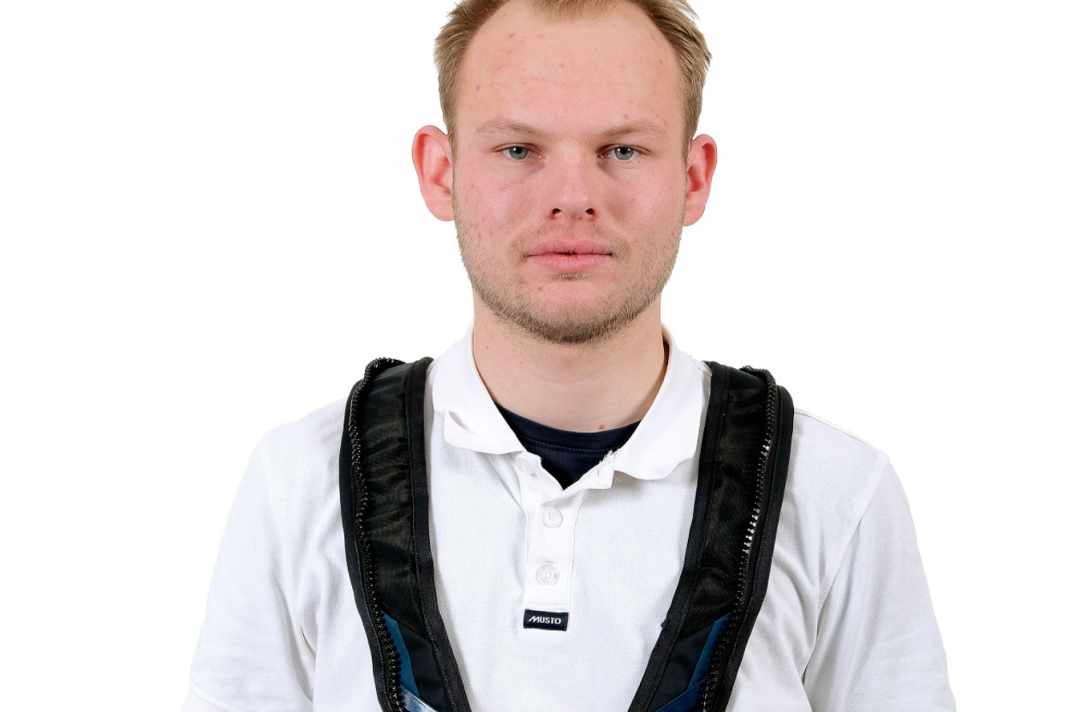


- Provider: decathlon.com
- Manufacturer: Tribord
- Price (15): 220 € (6)
- Buoyancy: 180 N
- Propellant cylinder/triggering: 38 g/water contact
- Automatic machine: UML-5
- Viewing window/control: No/tablet/trigger
- Lifebelt: Belt loop, hard
- Belt concept adjustment: Adjustable back and chest straps. Buoyancy chamber can be separated from the harness
- Belt fastener: Buckle, stainless steel
- Crotch strap (4): Double (4)
- Spraycap (4): No (0)
- Signal light (4): Yes (4)
- Closure cover: Zip fastener
- Weight (10): 1.577/704 g (5)
- Funct. & swimming position (20): 20
- Freeboard (20): 13.3 cm (15)
- Additional equipment (3): Removable buoyancy, packing instructions printed on (3)
- Wearing comfort, belt adjustment (20): Chest strap adjustment not entirely intuitive. Plenty of room in the neck. Buoyancy removable (18)
- Remark: Very good swimming position, no wave channel, turns into unconscious position, comfortable
- YACHT rating: Good (72)
LJ900 150N
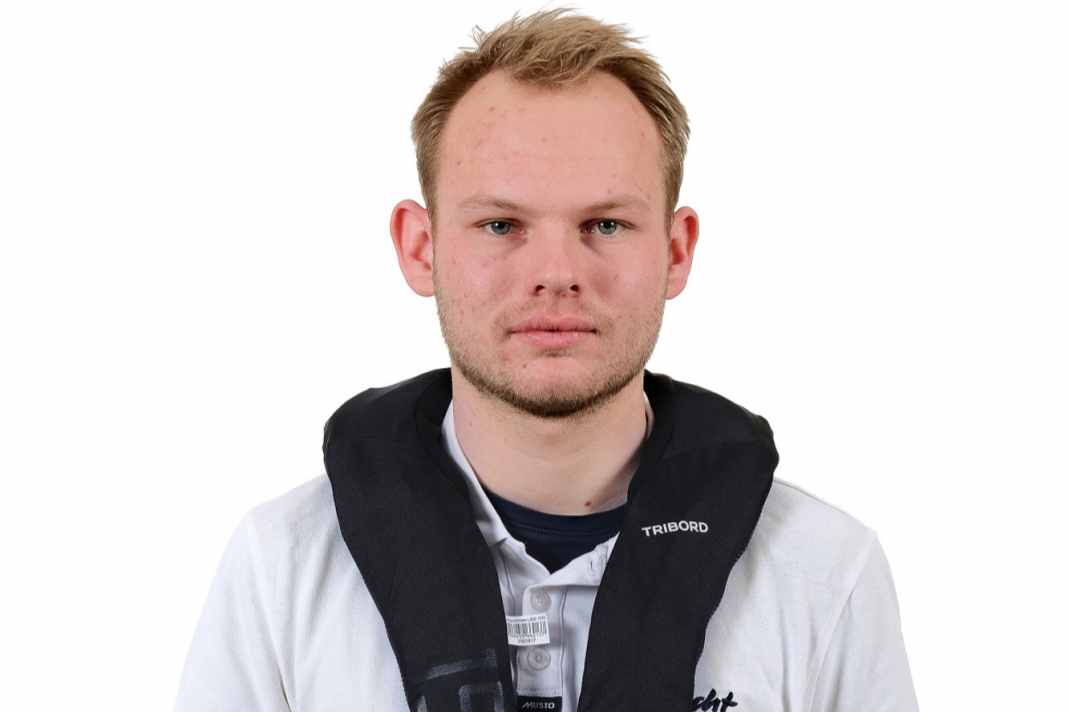


- Provider: decathlon.com
- Manufacturer: Tribord
- Price (15): 75 € (15) >> available here
- Buoyancy: 150 N
- Propellant cylinder/triggering: 33 g/water contact
- Automatic machine: UML-5
- Viewing window/control: No/tablet/trigger
- Lifebelt: Belt loop, soft
- Belt concept adjustment: Adjustable chest strap with buckle, self-stowing. Very basic
- Belt fastener: Buckle, stainless steel
- Crotch strap (4): Simple (4)
- Spraycap (4): No (0)
- Signal light (4): No (0)
- Closure cover: Zip fastener
- Weight (10): 981 g (8)
- Funct. & swimming position (20): 10
- Freeboard (20): 11.8 cm (8)
- Additional equipment (3): Nothing but cartridge fuse (1)
- Wearing comfort, belt adjustment (20): Yoke-shaped, somewhat awkward to put on at the collar. Strangles easily. Very simple harness (5)
- Remark: Very simple, buoyancy chamber leaves no wave channel, but is so shallow that water still comes to the mouth
- YACHT rating: Satisfactory (51)
Poseidon



- Provider: element-2.de
- Manufacturer: Baltic
- Price (15): 230 € (5)
- Buoyancy: 150 N
- Propellant cylinder/triggering: 33 g/water contact
- Automatic machine: UML Pro Sensor Elite
- Viewing window/control: Yes/tablet/cartridge
- Lifebelt: Belt loop, medium, small
- Belt concept adjustment: Back and chest straps adjustable on the left side, self-stowing
- Belt fastener: Buckle, Velcro
- Crotch strap (4): Simple (4)
- Spraycap (4): No (0)
- Signal light (4): No (0)
- Closure cover: Zip fastener
- Weight (10): 1.006 g (8)
- Funct. & swimming position (20): 15
- Freeboard (20): 11.8 cm (8)
- Additional equipment (3): Mesh in the collar (2)
- Wearing comfort, belt adjustment (20): Adjustment somewhat awkward. Plenty of space at the neck and nape. Very light (14)
- Remark: Buoyancy chamber closes well, no wave channel. Chokes a little on the neck
- YACHT rating: Satisfactory (56)
Seatec XD 220



- Provider: svb.de
- Manufacturer: Loading OÜ
- Price (15): 135 € (11)
- Buoyancy: 220 N
- Propellant cylinder/triggering: 33 g/water contact
- Automatic machine: UML Pro Sensor Elite
- Viewing window/control: Yes/tablet/cartridge
- Lifebelt: Belt loop, soft
- Belt concept adjustment: Adjustable chest strap with buckle, self-stowing
- Belt fastener: Buckle, stainless steel
- Crotch strap (4): Simple (4)
- Spraycap (4): No (0)
- Signal light (4): No (0)
- Closure cover: Zip fastener
- Weight (10): 1.029 g (8)
- Funct. & swimming position (20): 17
- Freeboard (20): 12.9 cm (13)
- Additional equipment (3): Fleece in the collar (2)
- Wearing comfort, belt adjustment (20): Simple harness, awkward adjustment. Somewhat cramped in the neck (11)
- Remark: Buoyancy chamber has a lot of volume on the chest, no wave channel, sits comfortably
- YACHT rating: Good (66)
Seatec X-Pro 180
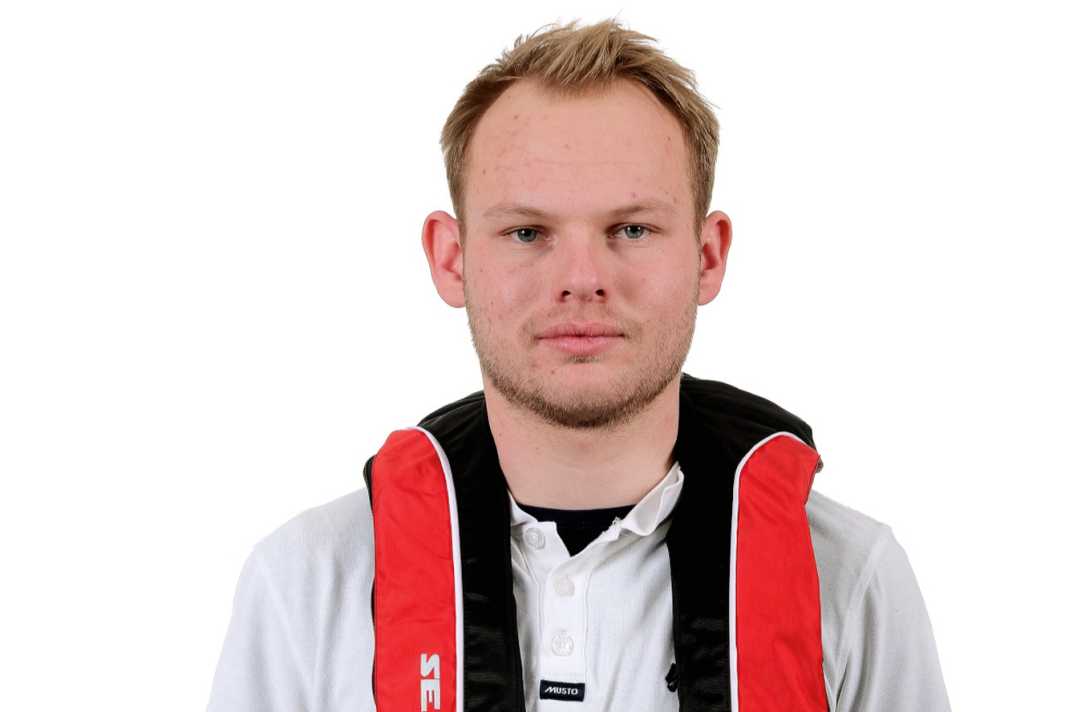


- Provider: svb.de
- Manufacturer: Loading OÜ
- Price (15): 120 € (12)
- Buoyancy: 180 N
- Propellant cylinder/triggering: 38 g/water contact
- Automatic machine: UML Pro Sensor Elite
- Viewing window/control: Yes/tablet/cartridge
- Lifebelt: D-ring, stainless steel
- Belt concept adjustment: Chest strap adjustable at the buckle of the fastener, self-stowing
- Belt fastener: Buckle, stainless steel
- Crotch strap (4): Simple (4)
- Spraycap (4): No (0)
- Signal light (4): No (0)
- Closure cover: Zip fastener
- Weight (10): 1.080 g (7)
- Funct. & swimming position (20): 15
- Freeboard (20): 9.9 cm (0)
- Additional equipment (3): Velcro removable fleece collar (2)
- Wearing comfort, belt adjustment (20): Chest strap adjustment not intuitive. Constricts the neck (8)
- Remark: Comfortable on the neck, floating position is ok, no wave channel. Little freeboard
- YACHT rating: Satisfactory (48)
Read also:
All content in this security special:
- Sea survival training for emergencies
- Stretch ropes: The correct handling of lifelines
- Lifejackets: 24 automatic lifejackets in a large comparison test (150N & 275N)
- Emergency transmitters - alerting, searching and finding, a system overview
- You should master these MOB manoeuvres!
- Back on board with tricks and professional recovery aids
- Safety check: Inspection saves lives
- Prepared for an emergency: 6 checklists for 6 scenarios

